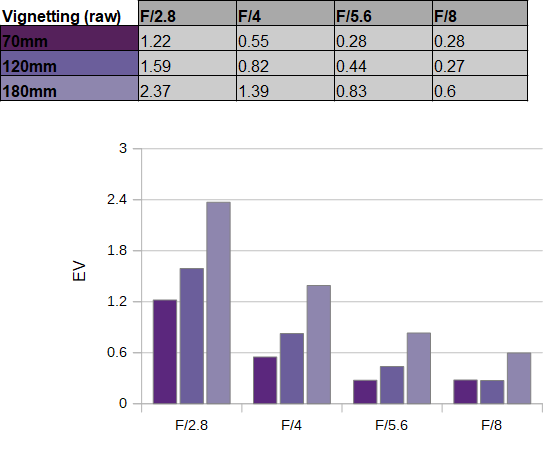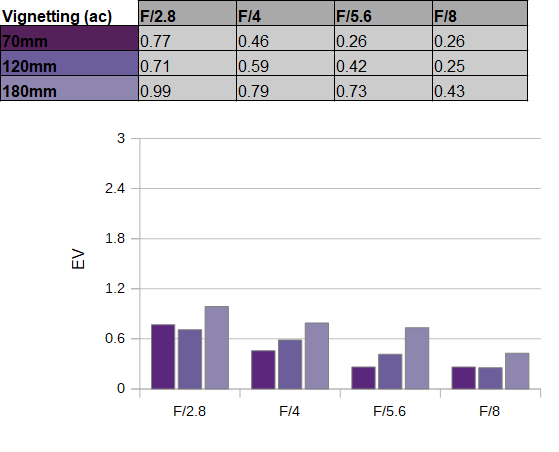|
Tamron 70-180mm f/2.8 Di III VXD - Review / Test Report - Analysis |
|
Lens Reviews -
Sony Alpha (Full Format)
|
|
Page 2 of 3

Distortion
The distortion characteristic of the Tamron 70-180mm f/2.8 Di III VXD is a bit of a mixed bag. Or in other words - it relies heavily on auto-correction. In RAW images, images are almost free of distortion at 70mm but it goes downhill from there. At 120mm we noticed a pincushion distortion of ~1.6% which is sort-of acceptable for such a lens but this increases to a whopping ~3% at 180mm which is among the worst (the worst?) that we have seen in this lens class.
With activated image auto-correction, the distortions are perfectly fine as you can see below. Please note that distortion-correction isn't lossless.
Vignetting
The RAW vignetting is slightly higher than average for a fast tele zoom lens. At maximum aperture, the light falloff remains relatively moderate at 70mm and 120mm but increases substantially to 2.4EV (f-stops) at 180mm. This is clearly visible in most scenes if you prefer to show without correction. Stopping down to f/4 reduces the issue to a non-disturbing degree in the lower range but at 180mm you'll need another stop for decent results.
 Thus it's best to stick with auto-correction which reduces the issue quite a bit. Tamron's correction profile is fairly moderate so some vignetting remains at f/2.8 and just under 1EV (f-stops). Another stop or two does help with reducing this further.
Thus it's best to stick with auto-correction which reduces the issue quite a bit. Tamron's correction profile is fairly moderate so some vignetting remains at f/2.8 and just under 1EV (f-stops). Another stop or two does help with reducing this further.

MTF (resolution)
A major strength of the Tamron 70-180mm f/2.8 Di III VXD is certainly its resolution characteristic. At 70mm and 120mm, the center quality is already great at f/2.8, and the outer image region is on a very good level. The peak performance at these settings is reached between f/4 and f/5.6 where the borders/corners also scratch the excellent mark. This changes slightly at 180mm. Surprisingly the center remains top-notch but the border-/corner-quality is reduced to a good level at f/2.8. This improves slightly at f/4 and f/5.6 albeit the borders/corners don't reach the sky-high levels that we have seen at the shorter focal lengths. Overall this is still very impressive especially with respect to the center quality.
The field curvature is low. The centering quality of the tested sample was good. We have noticed some residual spherical aberrations (=focus shifts) at 70mm which may also be the reason why the AF is trying to micro-correct following the initial focus at apertures smaller than f/2.8.
Please note that the MTF results are not directly comparable across the different systems!
Below is a simplified summary of the formal findings. The chart shows line widths per picture height (LW/PH) which can be taken as a measure for sharpness.
If you want to know more about the MTF50 figures you may check out the corresponding Imatest Explanations

Chromatic Aberrations (CAs)
A somewhat similar pattern can be observed with respect to CAs. They are almost negligible at 70-120mm whereas there's an increase at 180mm. With an average CA pixel width of 1-1.3px, the issue remains very manageable though. And, once again, it's nothing to worry about with auto-correction - which is lossless in this case.

Bokeh
If you invest in such a lens, you tend to do it for its depth-of-field capabilities, and, accordingly, the quality of the bokeh is an important criterion as well.
One aspect is the rendering of out-of-focus highlights. As you can see below, it isn't really a strength of this lens albeit to be fair - the comparable Sony lenses aren't really better either. The inner zone of the discs is fairly busy. On the positive side, the discs are pretty circular even at f/5.6 (in the center) and there's no obvious outlining.
 The shape of the highlights tends to deteriorate towards the image borders - this is due to mechanical vignetting. The Tamron lens does a good job here with circular discs being maintained across a pretty broad center zone. Cat eyes are obvious in the corners though. The "good" zone broadens when stopping down but the corners discs aren't really restored prior to f/5.6.
The general rendition in the focus transition zones is very smooth both in the background (shown to the left below) whereas the foreground (to the right) shows rather distinctive shadows at harsh contrast transitions.
The shape of the highlights tends to deteriorate towards the image borders - this is due to mechanical vignetting. The Tamron lens does a good job here with circular discs being maintained across a pretty broad center zone. Cat eyes are obvious in the corners though. The "good" zone broadens when stopping down but the corners discs aren't really restored prior to f/5.6.
The general rendition in the focus transition zones is very smooth both in the background (shown to the left below) whereas the foreground (to the right) shows rather distinctive shadows at harsh contrast transitions.

Bokeh Fringing (LoCA)
Bokeh fringing - also referred to as LoCAs - is a color fringing effect on the Z-axis. It shows up as purplish halos in front of the in-focus zone and greenish beyond.
It may be surprising but the Tamron 70-180mm f/2.8 Di III VXD does an excellent job in this respect. There are only traces of LoCAs visible at f/2.8 and they are gone by f/4. This is very rare and highly commendable - even more so for a rather affordable lens.
|